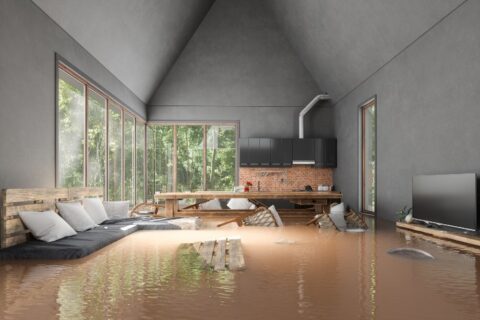10 Steps to Take When Water Isn’t Coming Out of Your Faucet
Imagine starting your day like normal, only to find that the kitchen or bathroom faucet isn’t working. No water in the house brings your routine to a standstill. If you find yourself thinking, “Why do I suddenly have no water?” this 10-step guide should help you troubleshoot common issues before contacting a plumber.
1. Try Another Faucet
If water isn’t coming out of a faucet, the first step is to try other plumbing fixtures to determine if it’s a house-wide problem. If only one faucet has stopped working, you’ve narrowed down the problem and can focus on troubleshooting that particular tap.
The simplest possibility is that the valve under the sink is closed. This can happen if someone recently worked on the faucet and forgot to turn the water back on. The fixture could also be clogged, dislodged, bent, or broken. The worst-case scenario is that you’ll have to replace the faucet, which isn’t a big deal.
2. Test Both Taps
Maybe only the hot or cold water is affected. If the cold side flows just fine, but the water won’t get hot, your water heater may have an issue. On the other hand, if the cold water runs dry, something could be wrong with the cold-water supply line. Pinpointing whether the problem affects the hot or cold water—or both—provides insight into what next steps to take next.
3. Check the Aerator for Clogs
All modern faucets have a small device on the spout called an aerator, which controls the water flow and reduces splashing by mixing air into the stream. A clogged aerator could be the culprit behind your water woes.
Over time, minerals in hard water build up inside the tiny holes, clogging the aerator and blocking water flow. Fortunately, you can easily unscrew the aerator and examine it more closely. If you see white mineral deposits, soak the aerator in a bowl of vinegar overnight to clean it and resolve the issue.
4. Check Your Main Water Shut-Off Valve
A common cause of no water in the house suddenly involves the main water shut-off valve. Often located near your water meter or inside the house near the water heater, this valve regulates water flow throughout the entire house. If you’re experiencing an interrupted water supply, the valve may be partially or fully closed.
Locate the main water shut-off valve and turn it counter-clockwise as far as it will go to immediately solve your problem. You may need pliers or a wrench to do this. If the valve is impossible to turn, it may be corroded. In this case, you’ll need to hire a plumber to replace it.
5. Ask Your Neighbors
A sudden water outage might not be unique to your house. To determine if the issue is affecting other households, consult with your neighbors. If they, too, are experiencing no water, the supply company may have turned off the water on your street or even in your entire neighborhood for maintenance work. You should have received a warning about this, but sometimes notices get overlooked.
6. Call Your Water Company
Once you’ve determined the water issue is not confined to your house, it’s time to contact your local water company. A representative should be able to answer questions about service disruptions in your area, planned maintenance, or other issues affecting your water supply.
Be aware that it might be worth calling your water company even if the problem only affects your home. After all, an unpaid water bill could be enough to interrupt your water supply. Confirm that your account is in good standing and that all your bills are up-to-date when troubleshooting no water in the house.
7. Consider the Possibility of Frozen Pipes
During cold snaps in the winter, frozen pipes can block water flow to one or more faucets. If temperatures have recently dropped well below freezing, and now you’re suddenly without water, your pipes may have frozen. Besides reduced water flow, other signs of frozen pipes include visible frost, unusual odors from the faucet or drain, and cold temperatures near exposed pipes.
To resolve the problem, start by opening the affected faucets slightly to allow melting ice to flow out. Then, gently warm your pipes using a hair dryer, heating pad, space heater, or hot towels. If you’re unable to locate or safely thaw the frozen area, call a plumber to avoid the possibility of burst pipes.
8. Look for Leaky or Dented Pipes
Leaks or dents can restrict water flow or, in more severe cases, stop it completely. Examine any visible piping for signs of leakage or physical damage. If you spot any problems, you’ll need a professional to repair or replace the faulty sections.
9. Check for Sediment Buildup
Over time, sediment can accumulate in your water supply lines, reducing the flow to your faucets. If you’ve noticed a gradual decrease in water pressure leading up to your current problem, sediment buildup is a likely cause. This problem requires a professional plumber to clear the buildup or replace the pipes.
10. Check Your Water Pump
If you live in a rural area, you may get your water from a well. If you find your well pump not working, this could result in no water in your house. Regular maintenance and occasional inspections can prevent sudden pump failures. However, you’ll need to call a repair specialist if your water pump suddenly stops working.
Plumbing Services in Utah County
Did you follow these 10 troubleshooting steps? Are you still scratching your head? If so, it’s time to call a plumber. Triple T Heating, Cooling & Plumbing is a family-owned and operated business providing top-notch plumbing services in Utah County. With 50 years of industry experience and a dedicated team of licensed and certified plumbers, you can trust us to get your water flowing again. The next time your faucets run dry, call us at 801-798-7711 or contact us online for immediate assistance.


